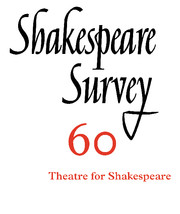Book contents
- Frontmatter
- Professional Players in the Guild Hall, Stratford-upon-Avon, 1568–1597
- Reconstructing The Rose: Development of the Playhouse Building between 1587 and 1592
- The Rose and its Stages
- Philip Henslowe and the Elizabethan Court
- From Revels to Revelation: Shakespeare and the Mask
- Bride-ing the Shrew: Costumes that Matter
- ‘When Men and Women are Alone’: Framing the Taming in India
- The Crown and the Pillow: Royal Properties in Henry IV
- Humanity at Stake: Man and Animal in Shakespeare’s Theatre
- Popular Shakespeare in Japan
- ‘Philosophy in a Gorilla Suit’: Do Shakespearians Perform or Just Perform-a-tive?
- Sudokothellophobia: Writing Hypertextually, Performatively
- Living Monuments: The Spatial Politics of Shakespeare’s Rome on the Contemporary Stage
- ‘In Windsor Forest and at the Boar’s Head’: The ‘Falstaff Plays’ and English Music in the Early Twentieth Century
- Michael Bogdanov in Conversation
- The Mouse and the Urn: Re-Visions of Shakespeare from Voltaire to Ducis
- ‘I covet your skull’: Death and Desire in Hamlet
- Martin Droeshout Redivivus: Reassessing the Folio Engraving of Shakespeare
- Canonizing Shakespeare: The Passionate Pilgrim, England’s Helicon and the Question of Authenticity
- Rereading Shakespeare: The Example of Richard Brathwait
- Shakespeare Performances in England, 2006: January 2006
- Professional Shakespeare Productions in the British Isles January–December 2005
- he Year's Contributions to Shakespearian Study 1 Critical Studies
- 2 Shakespeare in Performance
- 3 Editions and Textual Studies
- Index
Living Monuments: The Spatial Politics of Shakespeare’s Rome on the Contemporary Stage
Published online by Cambridge University Press: 28 November 2007
- Frontmatter
- Professional Players in the Guild Hall, Stratford-upon-Avon, 1568–1597
- Reconstructing The Rose: Development of the Playhouse Building between 1587 and 1592
- The Rose and its Stages
- Philip Henslowe and the Elizabethan Court
- From Revels to Revelation: Shakespeare and the Mask
- Bride-ing the Shrew: Costumes that Matter
- ‘When Men and Women are Alone’: Framing the Taming in India
- The Crown and the Pillow: Royal Properties in Henry IV
- Humanity at Stake: Man and Animal in Shakespeare’s Theatre
- Popular Shakespeare in Japan
- ‘Philosophy in a Gorilla Suit’: Do Shakespearians Perform or Just Perform-a-tive?
- Sudokothellophobia: Writing Hypertextually, Performatively
- Living Monuments: The Spatial Politics of Shakespeare’s Rome on the Contemporary Stage
- ‘In Windsor Forest and at the Boar’s Head’: The ‘Falstaff Plays’ and English Music in the Early Twentieth Century
- Michael Bogdanov in Conversation
- The Mouse and the Urn: Re-Visions of Shakespeare from Voltaire to Ducis
- ‘I covet your skull’: Death and Desire in Hamlet
- Martin Droeshout Redivivus: Reassessing the Folio Engraving of Shakespeare
- Canonizing Shakespeare: The Passionate Pilgrim, England’s Helicon and the Question of Authenticity
- Rereading Shakespeare: The Example of Richard Brathwait
- Shakespeare Performances in England, 2006: January 2006
- Professional Shakespeare Productions in the British Isles January–December 2005
- he Year's Contributions to Shakespearian Study 1 Critical Studies
- 2 Shakespeare in Performance
- 3 Editions and Textual Studies
- Index
Summary
Upon a close view of this story, there appear’d in some passages, no small resemblance with the busy faction of our own time. And I confess, I chose rather to set the parallel nearer to Sight, than to throw it off to further Distance.
Nahum Tate, The Ingratitude of the Common-Wealth; or the fall of Caius Martius CoriolanusWhat is the city but the people? – William Shakespeare. Sign on hoardings covering the City Center Shopping Mall, Minneapolis, during its refurbishment, 2006.
In the California Building Gallery in South Minneapolis, Aidan, a nine-year-old boy is trying to get the attention of the actor playing his father, in a workshop production of Shakespeare’s Coriolanus. The actors are having a break and are discussing the end of the presentation: how will the company leave the playing space once Martius has been killed? F1 has the Volscians leave the stage ‘bearing the dead body of Martius’. If we have Jim Bovino, who is playing Martius, carried off stage, it must be through the audience, as they surround the action throughout the piece. No one is taking much notice of Aidan. He starts to mould his onstage father into a monumental pose, right arm curved in front of him, fist clenched, left arm up as if brandishing a sword. Having studiously ignored this activity for a while, it occurs to Bovino that Aidan’s idea for a human sculpture is something of an inspired one, and the Coriolanus that I directed for Flaneur Productions in the California Building Gallery, Minneapolis, and Rochester Art Center, Rochester, Minnesota in April 2006, ended as the Volscians hauled Martius onto his feet, onto the block where he has just been killed and on which he had stood to receive the citizens’ vote in his gown of humility in 2.3. At the end of each performance, Martius’ son climbed onto the block, pulled from his father the Volscian shirt Martius had acquired when he left Rome for Actium and moulded him into a monument to Roman virtus. Or Mother Russia. Or Saddam Hussein. Or the Statue of Liberty, perhaps. When the boy was satisfied with the monument he had made of his father, he left the playing space.
- Type
- Chapter
- Information
- Shakespeare Survey , pp. 170 - 183Publisher: Cambridge University PressPrint publication year: 2007



